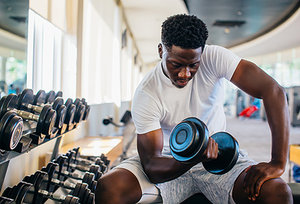Half the Effort ... Same Results?
By Editorial Staff
While a certain percentage of people can't wait to hit the gym every day, if you're like most people, it can be a daily grind. Between competing family, job and other responsibilities, most of us are so worn down by the end of the day (or the start of the next one) that the thought of exercising is low on the list of priorities.
But what if you could cut your exercise effort, specifically your weight-training effort, in half ... and still achieve the same results? You can.
An eccentric contraction is the lowering or releasing part of a movement. If you're doing dumbbell biceps curls, for example, the eccentric portion of the movement is when you extend your arms back down after curling it up (what most people consider the conclusion of one repetition). By comparison, the concentric contraction is the first portion of the movement – raising the weight up and contracting your biceps. Researchers recently discovered that people who perform only the eccentric part of the movement increase muscle strength and size as much as doing the entire movement (raising and lowering; concentric and eccentric).
Their study divided exercisers into four groups for comparison. Three groups performed three different dumbbell curl exercises, but one group raised and lowered the weights with each repetition, a second group performed only the raising (concentric) portion of each repetition, while the third group only performed the eccentric (lowering) portion. A fourth group performed no lifting exercises during the study period.
 After five weeks, strength gains were similar between the group that performed "full" repetitions (concentric and eccentric) and the eccentric-only group. And in terms of muscle thickness / hypertrophy, the eccentric-only group actually made greater gains than the concentric-eccentric group.
After five weeks, strength gains were similar between the group that performed "full" repetitions (concentric and eccentric) and the eccentric-only group. And in terms of muscle thickness / hypertrophy, the eccentric-only group actually made greater gains than the concentric-eccentric group.
So, how do you perform an eccentric-only repetition? After all, even if you're only lowering a weight, you have to raise it back up to get to your starting point, right? The easiest way to do it by yourself, using the dumbbell curl example, is to do single-arm curls. Each time you raise the weight, use your opposite hand to support the weight and "push" it up. On the way down (the eccentric contraction), engage the muscle and do the work. You'll only be doing half the work ... and getting the same (or even better) results! (If you have a workout partner, they can also provide the impetus for the concentric contraction.)
If nothing else, this study emphasizes what many gym-goers overlook on a routine basis: the power of the eccentric contraction. Each repetition of each exercise involves two important steps: concentric and eccentric. If you're only lifting the weight (concentric), but then essentially "dropping" it back down to the starting position, you're not taking advantage of the eccentric contraction this study shows is so valuable (not to mention increasing your injury risk). Talk to your doctor for more information.

